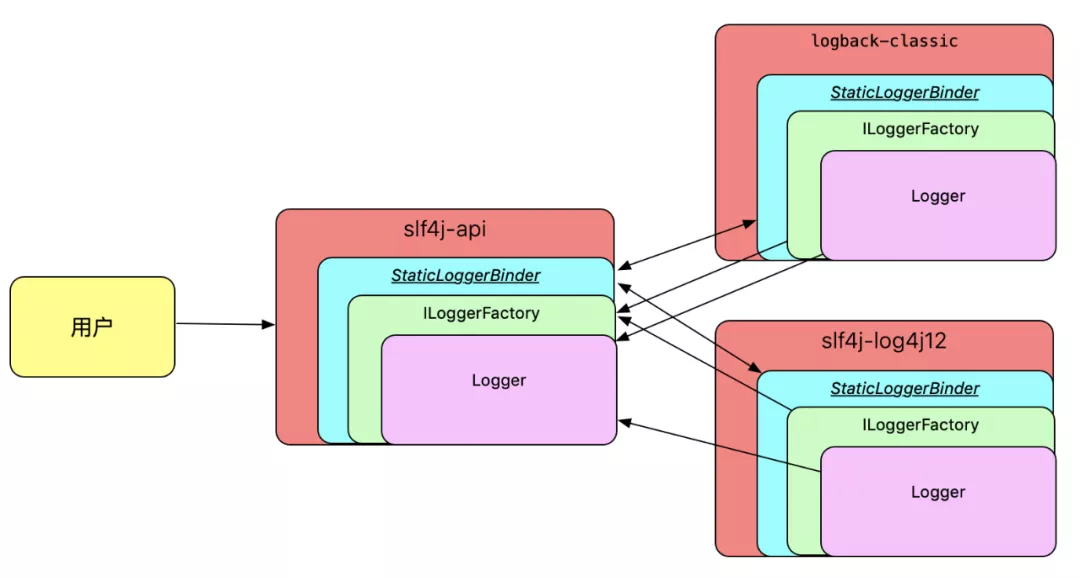概要
slf4j只是为日志的输出提供了统一接口,并没有具体的实现,就好像JDBC一样。那么,大家会不会好奇slf4j是怎么绑定/适配/桥接到log4j或者logback其他日志实现组件的呢?
适配过程原理
统计API接口,说明slf4j使用的是门面模式(Facade),然后就很容易猜测到大致的调用过程是,slf4j是通过自己的api去调用实现组件的api,这样来完成适配的。重点看看是怎么做到适配的。
源码基于slf4j-api.1.7.25
slf4j通用门面的实现
调用slf4j时都是使用它的api,首先需要获取它的logger
一般使用slf4j都是这样子的
import org.slf4j.Logger;import org.slf4j.LoggerFactory;private Logger logger = LoggerFactory.getLogger(LogTest.class);
getLogger
对getLogger()方法源码跟踪下去
public static Logger getLogger(Class<?> clazz) {Logger logger = getLogger(clazz.getName());if (DETECT_LOGGER_NAME_MISMATCH) {Class<?> autoComputedCallingClass = Util.getCallingClass();if (autoComputedCallingClass != null && nonMatchingClasses(clazz, autoComputedCallingClass)) {Util.report(String.format("Detected logger name mismatch. Given name: \"%s\"; computed name: \"%s\".", logger.getName(),autoComputedCallingClass.getName()));Util.report("See " + LOGGER_NAME_MISMATCH_URL + " for an explanation");}}return logger;}public static Logger getLogger(String name) {//获取logger的工厂来生成loggerILoggerFactory iLoggerFactory = getILoggerFactory();return iLoggerFactory.getLogger(name);}
从ILoggerFactory的名字上来看,这是一个接口,而它又可以生成到具体实际的logger,那应该猜测到这个ILoggerFactory会跟其他日志实现相关,但是例如log4j,自己的实现肯定不会关心slf4j的呀,所以应该由适配jar包,即slf4j-log4j12.jar来实现。
继续看代码
public static ILoggerFactory getILoggerFactory() {//从ILoggerFactory的状态可以看出,ILoggerFactory只会一次初始化if (INITIALIZATION_STATE == UNINITIALIZED) {synchronized (LoggerFactory.class) {//同步语句 + 双重判断,防止多次初始化//如果还没初始化,则进行初始化if (INITIALIZATION_STATE == UNINITIALIZED) {INITIALIZATION_STATE = ONGOING_INITIALIZATION;performInitialization();}}}switch (INITIALIZATION_STATE) {//初始化成功,即绑定成功,则从StaticLoggerBinder获取ILoggerFactory并返回case SUCCESSFUL_INITIALIZATION:return StaticLoggerBinder.getSingleton().getLoggerFactory();case NOP_FALLBACK_INITIALIZATION:return NOP_FALLBACK_FACTORY;case FAILED_INITIALIZATION:throw new IllegalStateException(UNSUCCESSFUL_INIT_MSG);case ONGOING_INITIALIZATION:return SUBST_FACTORY;}throw new IllegalStateException("Unreachable code");}//对ILoggerFactory的状态做说明static final int UNINITIALIZED = 0; //没初始化static final int ONGOING_INITIALIZATION = 1; //正在初始化static final int FAILED_INITIALIZATION = 2; //初始化失败static final int SUCCESSFUL_INITIALIZATION = 3; //初始化成功static final int NOP_FALLBACK_INITIALIZATION = 4; //无日志实现
bind
performInitialization()方法看来是重点
private final static void performInitialization() {bind();if (INITIALIZATION_STATE == SUCCESSFUL_INITIALIZATION) {versionSanityCheck();}}
bind()方法
private final static void bind() {try {Set<URL> staticLoggerBinderPathSet = null;if (!isAndroid()) {//找出可能绑定的日志的path,其实即StaticLoggerBinder.class文件staticLoggerBinderPathSet = findPossibleStaticLoggerBinderPathSet();//如果找出多个的话则打印错误信息。(等下会演示)reportMultipleBindingAmbiguity(staticLoggerBinderPathSet);}//通过获取单例来做初始化StaticLoggerBinder.getSingleton();INITIALIZATION_STATE = SUCCESSFUL_INITIALIZATION;//打印实际绑定的那个日志实现。(等下会演示)reportActualBinding(staticLoggerBinderPathSet);fixSubstituteLoggers();replayEvents();// release all resources in SUBST_FACTORYSUBST_FACTORY.clear();} catch (NoClassDefFoundError ncde) {String msg = ncde.getMessage();if (messageContainsOrgSlf4jImplStaticLoggerBinder(msg)) {INITIALIZATION_STATE = NOP_FALLBACK_INITIALIZATION;Util.report("Failed to load class \"org.slf4j.impl.StaticLoggerBinder\".");Util.report("Defaulting to no-operation (NOP) logger implementation");Util.report("See " + NO_STATICLOGGERBINDER_URL + " for further details.");} else {failedBinding(ncde);throw ncde;}} catch (java.lang.NoSuchMethodError nsme) {String msg = nsme.getMessage();if (msg != null && msg.contains("org.slf4j.impl.StaticLoggerBinder.getSingleton()")) {INITIALIZATION_STATE = FAILED_INITIALIZATION;Util.report("slf4j-api 1.6.x (or later) is incompatible with this binding.");Util.report("Your binding is version 1.5.5 or earlier.");Util.report("Upgrade your binding to version 1.6.x.");}throw nsme;} catch (Exception e) {failedBinding(e);throw new IllegalStateException("Unexpected initialization failure", e);}}
StaticLoggerBinder类
findPossibleStaticLoggerBinderPathSet()方法
从hard code看重要性,org/slf4j/impl/StaticLoggerBinder.class就是slf4j日志适配的关键
//hard codeprivate static String STATIC_LOGGER_BINDER_PATH = "org/slf4j/impl/StaticLoggerBinder.class";static Set<URL> findPossibleStaticLoggerBinderPathSet() {Set<URL> staticLoggerBinderPathSet = new LinkedHashSet<URL>();try {//获取LoggerFactory,即slf4j-apoi的类加载器ClassLoader loggerFactoryClassLoader = LoggerFactory.class.getClassLoader();Enumeration<URL> paths;//为null说明是由Bootstrap Classloader加载的,则转为App Classloader去加载if (loggerFactoryClassLoader == null) {paths = ClassLoader.getSystemResources(STATIC_LOGGER_BINDER_PATH);} else {//用跟slf4j一样的Classloader去加载paths = loggerFactoryClassLoader.getResources(STATIC_LOGGER_BINDER_PATH);}while (paths.hasMoreElements()) {URL path = paths.nextElement();staticLoggerBinderPathSet.add(path);}} catch (IOException ioe) {Util.report("Error getting resources from path", ioe);}return staticLoggerBinderPathSet;}
从类加载器的用法说明,org/slf4j/impl/StaticLoggerBinder.class要跟slf4j-api.jar包在同一个类加载器中,一般来说即要求放在同一路径下比较稳妥,当然也可以通过-classpath来指定。
前面已经猜测org/slf4j/impl/StaticLoggerBinder应该是由各种适配器来实现的,来看看
在IDE的类搜索,可以找到两个StaticLoggerBinder
调试刚刚的源码,可以看到找到了两个StaticLoggerBinder.class文件
那是因为这里依赖了
<dependency><groupId>ch.qos.logback</groupId><artifactId>logback-classic</artifactId><version>${logback.version}</version></dependency><dependency><groupId>org.slf4j</groupId><artifactId>slf4j-log4j12</artifactId><version>${slf4j.version}</version></dependency>
所以只是看到logback和log4j的适配器包。slf4j是对每一种日志实现都有对应的一个适配实现。适配器包的具体内容等下再看。(PS:这不是一个好的依赖配置,等下会说)
到这里已经找到了StaticLoggerBinder类了,StaticLoggerBinder是由各自的slf4j适配器包提供的。
这里有个trick,既然StaticLoggerBinder在slf4j-api有,也在其他logback-classic或slf4j-log4j12有,那么怎么确保JVM只加载到适配器包中的StaticLoggerBinder?其实看看slf4j代码的pom.xml就发现,答案是打包时是没有StaticLoggerBinder打进去的,这样slf4j-api.jar包是没有StaticLoggerBinder类的,JVM在找类时只会找到其他jar包的StaticLoggerBinder。
刚刚的源码到bind()方法的这一句
StaticLoggerBinder.getSingleton();
这一句其实已经是调用适配包的代码,将会看到logback和log4j对应StaticLoggerBinder类的代码。
对logback适配实现
从上面的依赖可以看出,为什么slf4j对logback的适配是在logback-classic.jar包呢?logback-classic应该是logback的核心包才对,不应该关心slf4j的。那是因为slf4j和logback是同一个作者,所以才说logback是天然集成slf4j的。
来看看logback-classic.jar中的StaticLoggerBinder
static {SINGLETON.init();}public static StaticLoggerBinder getSingleton() {return SINGLETON;}void init() {try {try {new ContextInitializer(defaultLoggerContext).autoConfig();} catch (JoranException je) {Util.report("Failed to auto configure default logger context", je);}// logback-292if (!StatusUtil.contextHasStatusListener(defaultLoggerContext)) {StatusPrinter.printInCaseOfErrorsOrWarnings(defaultLoggerContext);}contextSelectorBinder.init(defaultLoggerContext, KEY);initialized = true;} catch (Exception t) { // see LOGBACK-1159Util.report("Failed to instantiate [" + LoggerContext.class.getName() + "]", t);}}
上面的就是logback的初始化了。
public ILoggerFactory getLoggerFactory() {if (!initialized) {return defaultLoggerContext;}if (contextSelectorBinder.getContextSelector() == null) {throw new IllegalStateException("contextSelector cannot be null. See also " + NULL_CS_URL);}return contextSelectorBinder.getContextSelector().getLoggerContext();}
getLoggerFactory()方法会返回logback的LoggerContext,而LoggerContext是继承slf4j的ILoggerFactory的,这样就适配到slf4j。Logger是从LoggerFactory取出的。
看看LoggerContext的getLogger()方法
public final Logger getLogger(final Class<?> clazz) {return getLogger(clazz.getName());}@Overridepublic final Logger getLogger(final String name) {if (name == null) {throw new IllegalArgumentException("name argument cannot be null");}// if we are asking for the root logger, then let us return it without// wasting timeif (Logger.ROOT_LOGGER_NAME.equalsIgnoreCase(name)) {return root;}int i = 0;Logger logger = root;// check if the desired logger exists, if it does, return it// without further ado.Logger childLogger = (Logger) loggerCache.get(name);// if we have the child, then let us return it without wasting timeif (childLogger != null) {return childLogger;}// if the desired logger does not exist, them create all the loggers// in between as well (if they don't already exist)String childName;while (true) {int h = LoggerNameUtil.getSeparatorIndexOf(name, i);if (h == -1) {childName = name;} else {childName = name.substring(0, h);}// move i left of the last pointi = h + 1;synchronized (logger) {childLogger = logger.getChildByName(childName);if (childLogger == null) {childLogger = logger.createChildByName(childName);loggerCache.put(childName, childLogger);incSize();}}logger = childLogger;if (h == -1) {return childLogger;}}}
这里涉及了logback很多逻辑,不太需要理会。这里主要看logback的Logger其实是继承了slf4j的Logger,这样就适配到slf4j。
对log4j配置实现
看了logback的适配,就猜到log4j的也差不多
slf4j-log4j12的StaticLoggerBinder
private StaticLoggerBinder() {loggerFactory = new Log4jLoggerFactory();try {@SuppressWarnings("unused")Level level = Level.TRACE;} catch (NoSuchFieldError nsfe) {Util.report("This version of SLF4J requires log4j version 1.2.12 or later. See also http://www.slf4j.org/codes.html#log4j_version");}}public ILoggerFactory getLoggerFactory() {return loggerFactory;}
Log4jLoggerFactory()是继承了slf4j的ILoggerFactory。继续看getLogger方法。
public Logger getLogger(String name) {Logger slf4jLogger = loggerMap.get(name);if (slf4jLogger != null) {return slf4jLogger;} else {org.apache.log4j.Logger log4jLogger;if (name.equalsIgnoreCase(Logger.ROOT_LOGGER_NAME))log4jLogger = LogManager.getRootLogger();elselog4jLogger = LogManager.getLogger(name);Logger newInstance = new Log4jLoggerAdapter(log4jLogger);Logger oldInstance = loggerMap.putIfAbsent(name, newInstance);return oldInstance == null ? newInstance : oldInstance;}}
这里又是把log4j的Logger包装成slf4j的Logger,适配到slf4j。
图解
总结
slf4j的适配原理是通过适配包的org/slf4j/impl/StaticLoggerBinder来做转承,适配包通过继承和使用slf4j-api的ILoggerFactory和Logger来完成适配。
在最新的版本(1.8.0)已经改为使用Java的SPI机制来实现,StaticLoggerBinder类已经不用了,改为SLF4JServiceProvider,这样就真正的面向接口编程了,不用打包时忽略StaticLoggerBinder。


